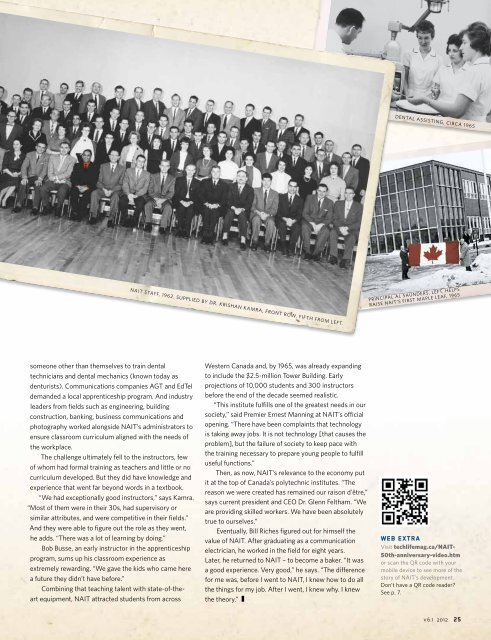JOURNAL OF APPLIED RESEARCH AND INNOVATION
Read the full print edition - techlife magazine
Read the full print edition - techlife magazine
Create successful ePaper yourself
Turn your PDF publications into a flip-book with our unique Google optimized e-Paper software.
dental assisting, circa 1965NAIT Staff, 1962. supplied by dr. Krishan Kamra, front row, fifth from left.principal al saunders, left, helpsraise nait’s first maple leaf, 1965someone other than themselves to train dentaltechnicians and dental mechanics (known today asdenturists). Communications companies AGT and EdTeldemanded a local apprenticeship program. And industryleaders from fields such as engineering, buildingconstruction, banking, business communications andphotography worked alongside NAIT’s administrators toensure classroom curriculum aligned with the needs ofthe workplace.The challenge ultimately fell to the instructors, fewof whom had formal training as teachers and little or nocurriculum developed. But they did have knowledge andexperience that went far beyond words in a textbook.“We had exceptionally good instructors,” says Kamra.“Most of them were in their 30s, had supervisory orsimilar attributes, and were competitive in their fields.”And they were able to figure out the role as they went,he adds. “There was a lot of learning by doing.”Bob Busse, an early instructor in the apprenticeshipprogram, sums up his classroom experience asextremely rewarding. “We gave the kids who came herea future they didn’t have before.”Combining that teaching talent with state-of-theartequipment, NAIT attracted students from acrossWestern Canada and, by 1965, was already expandingto include the $2.5-million Tower Building. Earlyprojections of 10,000 students and 300 instructorsbefore the end of the decade seemed realistic.“This institute fulfills one of the greatest needs in oursociety,” said Premier Ernest Manning at NAIT’s officialopening. “There have been complaints that technologyis taking away jobs. It is not technology [that causes theproblem], but the failure of society to keep pace withthe training necessary to prepare young people to fulfilluseful functions.”Then, as now, NAIT’s relevance to the economy putit at the top of Canada’s polytechnic institutes. “Thereason we were created has remained our raison d’être,”says current president and CEO Dr. Glenn Feltham. “Weare providing skilled workers. We have been absolutelytrue to ourselves.”Eventually, Bill Riches figured out for himself thevalue of NAIT. After graduating as a communicationelectrician, he worked in the field for eight years.Later, he returned to NAIT – to become a baker. “It wasa good experience. Very good,” he says. “The differencefor me was, before I went to NAIT, I knew how to do allthe things for my job. After I went, I knew why. I knewthe theory.”web extraVisit techlifemag.ca/NAIT-50th-anniversary-video.htmor scan the QR code with yourmobile device to see more of thestory of NAIT’s development.Don’t have a QR code reader?See p. 7.v6.1 2012 25










